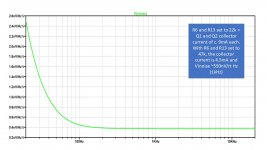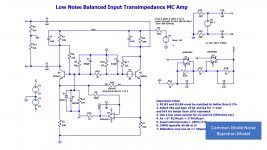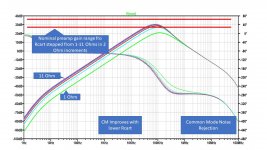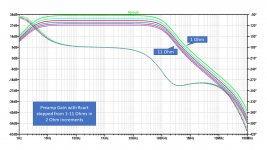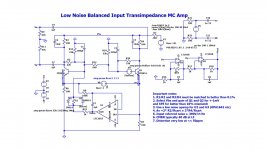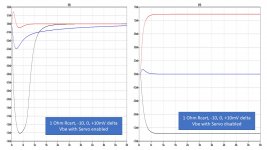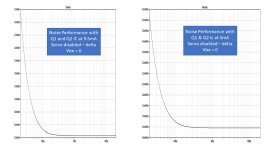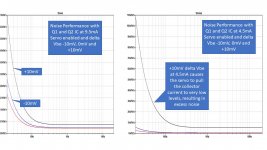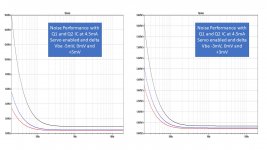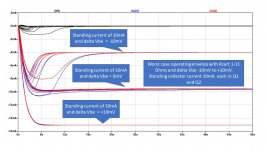The next slide is the noise performance. With 47k bias resistors, Q1 and Q2 run at c. 4.5mA which is a practical figure. If you are able to deal with 9-10mA collector currents, the input referred noise will drop to about 380pV/rt Hz (this is what is shown below). As mentioned in an earlier post, this is not as good as the X-Altra, but then with that pre, you don't have the benefit of a balanced input. That measured 232pV/rt Hz on one of the builds, and if the collector current in that design is upped from c. 3.5mA to say 7 or 8 mA, you can get the noise down to 200pV/rt Hz or a shade under.
Attachments
Last edited:
Here's a quick look at the CM performance. As mentioned earlier, capacitively coupled noise is unlikely to be a major issue in MC setups because of the low impedances involved and the low bandwidths (< 100kHz) - the main issue is mag field coupling. The involved inductances are probably of the order of 3-5uH excl. the cart inductance. I used a simple model to couple CM noise across the cart and then stepped the cart resistance from 1 Ohm to 11 Ohm in 2 Ohm increments. As expected, the CM at HF is not outstanding, but at LF it offers significant suppression of unwanted noise.
Attachments
Last edited:
Finally, here is the response with the cart resistance stepped from 1-11 Ohms.
The distortion for 500uV input and 12mV pk output was < 20ppm (20 kHz figure).
For those that want to play further with the circuit, the .asc file is attached below.
🙂
The distortion for 500uV input and 12mV pk output was < 20ppm (20 kHz figure).
For those that want to play further with the circuit, the .asc file is attached below.
🙂
Attachments
Last edited:
Bonsai,
I get a 450mA pulse through the Cart at switch on when using a 1R Cart, resp. a 20mA pulse for a 10R Cart.
Pulse is very short, but wouldn't it be better when this could be eliminated?
I tried inserting a coil in the uH range for the Cart, but thus didn't affect the pulse.
Hans
.
I get a 450mA pulse through the Cart at switch on when using a 1R Cart, resp. a 20mA pulse for a 10R Cart.
Pulse is very short, but wouldn't it be better when this could be eliminated?
I tried inserting a coil in the uH range for the Cart, but thus didn't affect the pulse.
Hans
.
Attachments
Is that with the 1k between the bases removed?
That pulse is c. 1 ns wide Hans.
If you integrate that over 1 sec it’s negligible - but I don’t know that the sim is even accurate at that time resolution.
That pulse is c. 1 ns wide Hans.
If you integrate that over 1 sec it’s negligible - but I don’t know that the sim is even accurate at that time resolution.
Yes, this was with the 1K resistor and everything else in place.
And yes it is a very short pulse, and the simulation is probably not very accurate, but nevertheless, it was just a warning with a first try without going in much detail.
But when connecting an expensive Cart, one want to be 100% sure that it is safe.
Hans
And yes it is a very short pulse, and the simulation is probably not very accurate, but nevertheless, it was just a warning with a first try without going in much detail.
But when connecting an expensive Cart, one want to be 100% sure that it is safe.
Hans
If my math is right, on a 10 Ohm cart that’s 2 W peak for 1 ns or an average power of 2 nano watt / seconds
😀
😀
power is in watts, whether averaged or not. watts/seconds is a rate of change of power, which here would be 2/1e-9 = 2GW/sIf my math is right, on a 10 Ohm cart that’s 2 W peak for 1 ns or an average power of 2 nano watt / seconds
I think you were thinking of energy, not rate of change of power, and the units for that are joules ( or watt-seconds ).
Not sure the cartridge does any averaging over a timescale of a second, any damage is likely due to either the peak mechanical force or total dumped thermal energy (the latter is clearly negligible and measured in nanojoules, which I think is what you mean?)
With a simple RC network on the 5Volt, 1R + 100uF the spike at start up is simply to be avoided.
But then follows what is visible in the 20 seconds image below, current going to 3mA and then very slowly diminishing.
This is realistically what happens IMO, and simply too much.
Hans
.
But then follows what is visible in the 20 seconds image below, current going to 3mA and then very slowly diminishing.
This is realistically what happens IMO, and simply too much.
Hans
.
Attachments
I will rerun the power-up sims today. Please note the rise fall times on my 5 V supply. I used a pulse source to simulate it.
Re energy in the cart coil - I quoted it was watt/seconds so I am speaking about energy.
Re energy in the cart coil - I quoted it was watt/seconds so I am speaking about energy.
Indeed Hans, you were correct. The servo was not working correclty as there were problems with my sim. Hopefully our sims will be better aligned.
Here is the circuit I am using with some updates
Here is the circuit I am using with some updates
Attachments
Last edited:
The final slide looks at Rcart and the action of the servo on the the collector current of Q1 and Q2. With max delta Vbe of 10mV, the shifts in Ic are around 5mA around the nominal 10mA used in this sim.
The conclusion here is that to maintain the Ic over a reasonable range, the delta Vbe of the devices should be matched to within 2mV (not too dissimilar to other bipolar input MC head amps).
MC Carts with 1 Ohm are then still handed well wrt cart start-up current, but this represents an outer operating envelop in any event, since most carts are 3 ohms and higher.
The conclusion here is that to maintain the Ic over a reasonable range, the delta Vbe of the devices should be matched to within 2mV (not too dissimilar to other bipolar input MC head amps).
MC Carts with 1 Ohm are then still handed well wrt cart start-up current, but this represents an outer operating envelop in any event, since most carts are 3 ohms and higher.
Attachments
Perhaps you could use a FET between the legs to shorten them until supply currents have settled, and then slowly open it so the servo can follow.
Or fasten up the servo during switch on.
Or fasten up the servo during switch on.
Hi Bonsai,
I will give my comments on your recent diagram when you allow me doing so.
One thing I don't like is the noise performance depending on Vbe offset.
It should be possible in all situations to stay close to the theoretical noise performance of 0.31nV/rtHz and 0.37nV/rtHz for resp an Ic of 9.5mA and 5mA, that is with no Cart adding to the noise.
With a 1R Cart this becomes resp. 0.33nV/rtHz and 0.39nV/rtHz.
Hans
I will give my comments on your recent diagram when you allow me doing so.
One thing I don't like is the noise performance depending on Vbe offset.
It should be possible in all situations to stay close to the theoretical noise performance of 0.31nV/rtHz and 0.37nV/rtHz for resp an Ic of 9.5mA and 5mA, that is with no Cart adding to the noise.
With a 1R Cart this becomes resp. 0.33nV/rtHz and 0.39nV/rtHz.
Hans
The increase in the noise Hans is because at the extreme situation (+10 mV delta Vbe difference), the collector current is pulled very low by the servo. These plots are shown to demonstrate the operating envelope of the circuit.
In a practical setup, you would select for say a max delta Vbe of 2 mV, then you don’t have this issue - the noise performance is good.
Note the base decoupling capacitors have been purposely made different to increase the cart current at startup. Normally they would both be the same value.
Re cart currents, these quickly drop off above 3 ohms so they are a few hundred uA max for a few seconds.
Feel free to comment - I am not against any discussion - this is why the circuit is up.
In a practical setup, you would select for say a max delta Vbe of 2 mV, then you don’t have this issue - the noise performance is good.
Note the base decoupling capacitors have been purposely made different to increase the cart current at startup. Normally they would both be the same value.
Re cart currents, these quickly drop off above 3 ohms so they are a few hundred uA max for a few seconds.
Feel free to comment - I am not against any discussion - this is why the circuit is up.
Last edited:
- Home
- Source & Line
- Analogue Source
- Low noise Balanced MC Pre
